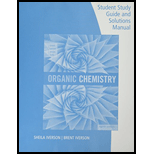
(a)
Interpretation:
Product of the given substitution reaction has to be written and mechanism for the reaction should be predicted.
Concept Introduction:
Structure of the substrate plays a major role in
(b)
Interpretation:
Product of the given substitution reaction has to be written and mechanism for the reaction should be predicted.
Concept Introduction:
Structure of the substrate plays a major role in
Trending nowThis is a popular solution!

Chapter 9 Solutions
Student Study Guide and Solutions Manual for Brown/Iverson/Anslyn/Foote's Organic Chemistry, 8th Edition
- A problem often encountered in the oxidation of primary alcohols to acids is that esters are sometimes produced as by-products. For example, oxidation of ethanol yields acetic acid and ethyl acetate: Propose a mechanism to account for the formation of ethyl acetate. Take into account the reversible reaction between aldehydes and alcohols:arrow_forwardWhen cyclohexene is reacted with hydrobromic acid in acetic acid, the major product is bromocyclohexane. There is a small amount of cyclohexyl acetate formed. What is the mechanism that forms both compounds? What is the purification procedure that isolates both compounds?arrow_forwardDraw the formulas of the reactants and products of the reaction: 2-ethylbutanoyl bromide with excess ethylmagnesium bromide and heating the product with concentrated H2SO4.arrow_forward
- When 2-iodo-1,4-dimethylcyclohexane is heated in acetic acid, CH3COOH, a mixture of substitution and elimination products is obtained. Provide structures for all possible products, writing [not drawing] the name of the mechanism by which each one is formed.arrow_forwardDraw all of the substitution and elimination products formed from the given alkyl halide with each reagent: (a) CH3OH; (b) KOH. Indicate the stereochemistry around the stereogenic centers present in the products, as well as the mechanism by which each product is formed.arrow_forwardWhen propene reacts with gaseous hydrogen bromide, HBr, two products, 1-bromopropane and 2-bromopropane are formed. The reaction is a two-step process in which the electrophilic attack occurs in the first step. Identify the electrophile in this reaction Draw a diagram showing the first step of the reaction that leads to the production of 2-bromopropane.arrow_forward
- When trans-2-chloro-1-cyclohexanol is treated with a base, cyclohexene oxide is the product. However, when cis-2-chloro-1-cyclohexanol is treated with a base, the product is cyclohexanone. Write the mechanism for each of the two reactions.arrow_forwardH3C CH3 H3C NA C→XT Br Br₂ CH₂Cl₂ H3C Electrophilic addition of bromine, Br₂, to alkenes yields a 1,2-dibromoalkane. The reaction proceeds through a cyclic intermediate known as a bromonium ion. The reaction occurs in an anhydrous solvent such as CH₂Cl₂. CH3 Br In the second step of the reaction, bromide is the nucleophile and attacks at one of the carbons of the bromonium ion to yield the product. Due to steric clashes, the bromide ion always attacks the carbon from the opposite face of the bromonium ion so that a product with anti stereochemistry is formed. Draw curved arrows to show the movement of electrons in this step of the mechanism. Arrow-pushing Instructions Br CH3 H3C CH3arrow_forwardDetermine the mechanism of nucleophilic substitution for attached reaction anddraw the products, including stereochemistry.arrow_forward
- 1) Nucleophilic substitution reaction of alkyl halide is a process when nucleophile replace the leaving group of alkyl halide. Propose the mechanism and product(s) for the following substitution reaction.arrow_forwardTwo substitution products result from the reaction between 3-chloro-3-methyl-1- butene with sodium acetate (CH3COO – Na +) in acetic acid under SN1. Identify the products.arrow_forwardAn alkene is treated with OsO4 followed by H2O2. When the resulting diol is treated with HIO4, the only product obtained is an unsubstituted cyclic ketone with molecular formula C6H10O. What is the structure of the alkene?arrow_forward
